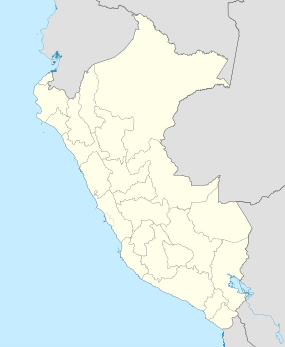Sechin Bajo

Archaeological site of Sechin Bajo overlooking the Sechin River Valley.
|
|
| Location | Ancash, Peru |
|---|---|
| Coordinates | 9°27′53″S 78°15′54″W / 9.46472°S 78.26500°WCoordinates: 9°27′53″S 78°15′54″W / 9.46472°S 78.26500°W |
| Type | Settlement |
| History | |
| Founded | c. 3500 BCE |
| Abandoned | c. 1000 BCE |
| Cultures | Casma/Sechin culture |
| Site notes | |
| Condition | In ruins |
Sechin Bajo is a large archaeological site with ruins dating from 3500 BCE to 1300 BCE, making it one of the oldest centers of civilization in the Western Hemisphere. Sechin Bajo is located in the valley of the Sechin River, about 12 kilometres (7.5 mi) from the Pacific Ocean and about 330 kilometres (210 mi) northwest of Lima, Peru. Sechin Bajo is one ruin among many located in close proximity to each other in the valleys of the Casma and Sechin Rivers.
In 2008, a German and Peruvian archaeological team, headed by Peter Fuchs, announced that a circular plaza, 10–12 meters (11-13 yards) in diameter and constructed of rocks and rectangular adobe bricks had been found at Sechin Bajo. Radiocarbon dating indicated that plaza was constructed in 3500 BCE. A nearby 2 meter-tall (2 yards) frieze was dated at 3600 BCE. The plaza and the frieze are the two oldest examples of monumental architecture discovered thus far in the Americas. Sechin Bajo may contend with sites of Norte Chico as the oldest urban settlement of the Americas.
The Peruvian Pacific coast is one of the driest deserts in the world with average annual precipitation of less than 10 millimetres (0.39 in). Along the 1,300 kilometres (810 mi) of Peruvian coast, 57 small rivers flow into the sea, watered by the higher precipitation received in the Andes Mountains inland at elevations higher than 2,500 metres (8,200 ft). Each river valley forms a linear oasis in which irrigated agriculture is possible. The valleys of the Casma River and its tributary, the Sechin River, are one of the linear oases. The ancient area of the Casma/Sechin culture extends about 40 kilometres (25 mi) inland from the sea. The width of the irrigable valleys range from one to seven kilometres (0.6 to 4.3 mi).
Located along about 4 kilometres (2.5 mi) in the Sechin River valley, just upstream from its junction with the Casma, is a complex of archaeological ruins that comprises sites such as Sechin Bajo, Sechin Alto, Cerro Sechin, and Taukachi-Konkan, all of them except Sechin Alto in the desert just beyond the edge of the irrigated river valley. The Casma valley was populated long before the monumental construction began. The oldest radio carbon date found at Sechin Bajo is 4500 BCE although other signs of human occupation of the Casma valley date back to before 6,000 BCE.
...
Wikipedia

